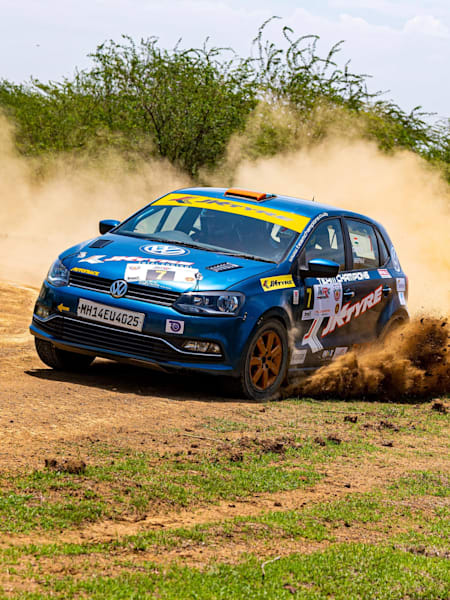Rally driver Dean Mascarenhas competes in the Indian National Rally Championship and won the first round of the 2019 edition of the competition in Chennai.
Ahead of the second round in Coimbatore, Dean took the time to explain how his rally car has been modified to help him get the best performance in rally stages, which was documented by photographer Srinivasa Krishnan.
Body work
On-road cars are fitted for the most comfortable and convenient drive for passengers. They have paddings, air conditioning, roof trims, proper dashboards, interior trims, and regular seats – all designed for a daily commute.
Rally cars are usually stripped down to the bone. The chassis is kitted with a bare outer shell that is strengthened and reinforced to take the battering of rally stages. The rally car is much lighter than on-road cars, which allows it to go faster. Rally cars have roll cages for additional safety, so the drivers are not hurt if there is a crash.
Seat and seat belts
Rally cars are fitted with FIA-approved bucket seats. The driver sinks into the seat with the sides hugging the driver, so they don’t slide around. Five-point harness seatbelts are used to keep drivers perfectly stationary even when the car bounces around.
Suspension and suspension canister
Rally cars are not fitted with suspension meant for long distances, which on-road cars usually have. Suspension in rally cars are meant to help drivers take corners, hit bumps and go through ruts at extremely high speeds. Dean uses the Reigers suspension which can be adjusted to setup the height clearance of the car, the stiffness of the suspension, how much the car would lean on turns, and much more. A suspension canister with knobs is used to adjust the softness of the suspension via compression.
Tyres
Most INRC cars use tyres made with a special compound, especially for rallies – they cannot be used for on-road cars. Dean uses tyres manufactured by JK Tyres for rallying. The tyres have an extremely strong sidewall which absorbs more impact in off-road conditions at high speeds. The tyres come in hard, medium and soft compounds, which drivers pick based on the terrain of the stages.
Engine
Engines are tested and tuned for best performance in rallies. Dean competes in INRC2, which does not allow for turbo in engines. Nevertheless, the regulations allow for many improvements to be made to the engine.
Engine control unit
The engine control unit manages fuel supply and air pressure in the engine. Dean has a modified engine control unit which helps him boost the performance of the car.
Skid plate
Rally cars are specially fitted with an impact guard called the skid plate, which is under the engine. It helps protect the gearbox from impact in case a stone hits it during high-speed rally stages. The skid plate on Dean’s car is a 5mm reinforced metal plate. International rally cars tend to use carbon fibre skid plates to reduce the weight of the car.
Bonnet and air scoops
Bonnet scoops help hot air from the engine to escape out of the car. Cold air enters through the engine grill, pushing hot air out through the bonnet scoop. This keeps cool air circulating around the engine, so the car doesn’t overheat.
Air scoops are installed in the roof of the car to allow cool air into the car. Rally cars do not have air conditioners so as to reduce the weight of the car. The only way to maintain cool air in the car is to fit the roof with air scoops to allow cool air to circulate through the cabin. Air scoops have in-built filters to stop dust from entering the cabin.
Bonnet and bumper clips
Bonnet clips are installed on rally cars since they are quicker and easier to handle in case of emergencies. The bonnet locks in on-road cars are usually placed under the bonnet, in the middle and can tend to get jammed. So rally drivers disable the stock bonnet lock and install bonnet clips for convenience. Bonnet locks also tend to release on impact, which would make them snap back and break the windshield. Bonnet clips secure the bonnet from the sides of the car and don’t release even in accidents.
Bumper clips are steel plates screwed onto the bumpers and metal fenders. These are an added feature on rally cars, so the bumper doesn’t fall off easily in a crash.
Helmet nets
Rally cars aren’t fit with passenger seats in the back of the vehicle. Instead, they have an accessory called the helmet net so drivers can drop in their helmets for easy access.
Fire extinguishers
With the risk of accidents being high, INRC cars are always required to carry two fire extinguishers in the cabin. One is placed just behind the pilot’s seat while the second is placed under the navigator’s legs.


















